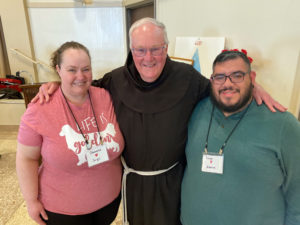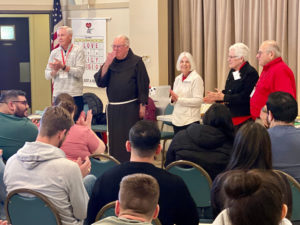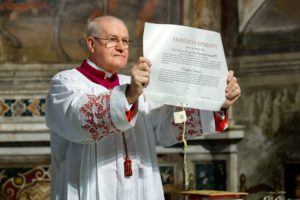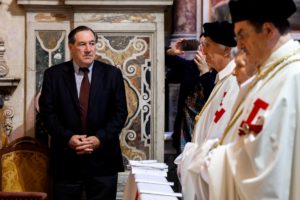As volunteers for Catholic Engaged Encounter (CEE), John and Amy Sabol have spent the last 28 years helping engaged couples plan for their big day by preparing them for what comes after their big day.
The Sabols, who’ve been married for 50 years, help run CEE weekend retreats where they encourage couples to bring God into their relationship and develop healthy communication habits, as a reminder that a wedding lasts a day, while a marriage lasts a lifetime.
The Sabols said their own marriage was strengthened by sharing their life story with retreat participants and explaining how forgiveness, open communication, and making a conscious decision to love your spouse even in difficult times can lead to a more fulfilling union.
“We always talk about how marriage is work,” said John, “but we also try to tell them that it’s worth it. Being in a good relationship with your partner is worth more than anything else.”
“We’ve learned that we’re kind of best friends as well as a married couple,” Amy added.
The Sabols are part of a global network of priests and married couples who present weekend retreats for CEE, an international Catholic marriage preparation program that grew out of the Marriage Encounter program about 50 years ago.
In the Archdiocese of Los Angeles, couples can meet marriage preparation requirements by completing a CEE weekend retreat.

Father Larry Gosselin, OFM, center, stands with engaged couple Jeannine MacAller and Jorge Anguiano during a recent Engaged Encounter weekend retreat. (Theresa Cisneros)
During the three-day gatherings, a presenting team — composed of a priest and married couples — delivers talks in a group setting touching on five major themes: “The Family We Grew Up In,” “Sacramental Marriage,” “Communication,” “Intimacy,” and “Values.” After the presentations, participants are given time to journal and share their reflections with their partners.
“The purpose of the weekend is to help the couples dig deeper into their relationship and make sure that they have discussed issues that are important to the relationship and maybe have been taking a backseat because they’re doing wedding planning,” John said. “The purpose is to get them to really communicate on a deeper level about all these topics.”
In April, the Sabols hosted a CEE retreat at the Sacred Heart Retreat House in Alhambra along with co-presenters Joe and Kathie Schneider and Father Larry Gosselin, OFM. Thirty-eight engaged couples from across the archdiocese — and beyond — attended.
The retreat kicked off Friday night with exercises designed to help participants get to know themselves better because, as the Sabols pointed out, participants need to know who they are as individuals before they can truly open up to their partners.
As the weekend progressed, the team went on to deliver 14 presentations on topics ranging from conflict management, fertility, finances, and more.
Couples also had the opportunity to write betrothal promises to each other, public pledges of love and commitment that detail the steps they plan to take to prepare for the sacrament of marriage.
The retreat wrapped with two final sessions on Sunday afternoon, in which participants shared their thoughts about the weekend and received certificates of completion while being cheered on by their peers.
Nearly 20 participants spoke, with many saying that the retreat exceeded their expectations and gave them a better understanding of the sacrament they would be celebrating.
“It was so much more than a church requirement,” one person said.
For Jada Selexman and Dominic Scaglione, of St. Clare of Assisi Church in Santa Clarita, the weekend provided an opportunity to dive deeper into topics they don’t often have time to discuss and prompted them to think more about the solemnity of their impending wedding Mass.
“It’s very grounding to hear that our wedding is not just about the reception and how much fun we’re going to have, but it’s about the ceremony and the sacrament itself,” Selexman said.

Married couples John and Amy Sabol and Joe and Kathie Schneider, along with Father Larry Gosselin, OFM, put on the Catholic Engaged Encounter retreat on April 5-7. (Theresa Cisneros)
For Tiffany Herrera and John Le, of Holy Family Church in South Pasadena, the retreat taught them how integrating more prayer and communication into their lives can help strengthen their relationship today and beyond.
“It just brought our level of intimacy to a whole new level,” Le said. “I really didn’t imagine that happening. I imagined us being closer to God, but never thought about what it means to have him be a part of our relationship. It just really makes me love her a lot more than I thought I would, coming out.”
For Jeannine MacAller and Jorge Anguiano, of Padre Serra Church in Camarillo, the CEE retreat had been a long time coming. The couple initially planned to get married in 2020, but their plans were derailed by the COVID-19 pandemic, MacAller’s fight with cancer, and other challenges.
The couple said the retreat taught them how to be vulnerable while communicating with each other, and further solidified their desire to bring God into their union.
“God is the center of our lives, and we want him at the center of our marriage,” MacAller said. “We know how much we have needed him as individuals and we need him just as much, if not more, as a married couple. I’m so glad we did this.”
Members of the presenting team said they were energized by participants’ zeal and desire to get married in the Catholic Church, even in today’s contemporary times.
“This is a sign that the Church is still very much alive and there’s still young people who desire to make their commitment as husband and wife in the sacrament of marriage in the Church,” said Gosselin, who’s been giving CEE retreats for about 40 years. “To see their excitement, and to see their joy and their enthusiasm about living their faith is rewarding.”
The Schneiders — who’ve been married for almost 60 years and have been volunteering for 45 years with CEE — said they continue to present weekend retreats as a way to give back.
The couple struggled early in their marriage, Joe Schneider said, and wishes they would’ve had a resource like CEE back then.
“It really gives us hope for the future, and hope for the Church,” he said. “And it keeps us honest. It challenges us to remember what we started out with and how, hopefully, we’ve grown.”





 Holy and Great WednesdayJudas stretched forth his hand to the lawless. She sought the remission of her sins, while he took the pieces of silver. The harlot brought myrrh to anoint the Lord; the disciple made an agreement with the lawless. She rejoiced when she spent the precious myrrh; he set out to sell Him who has no price. She recognized her Master, while he departed from his Master. She was freed from sin, but he became the captive of sin.
Holy and Great WednesdayJudas stretched forth his hand to the lawless. She sought the remission of her sins, while he took the pieces of silver. The harlot brought myrrh to anoint the Lord; the disciple made an agreement with the lawless. She rejoiced when she spent the precious myrrh; he set out to sell Him who has no price. She recognized her Master, while he departed from his Master. She was freed from sin, but he became the captive of sin. 
 Love of Money, the Sin of Distrust in GodSpeaking about love of money in our days is just the same as describing hot weather in summer. Everyone suffers torment from the scorching heat in July, and it seems there is no way to hide from it, though there are air conditioners, fans, shady places, and cold water. Very few people like the blazing sun, while the love of money captures our hearts and enslaves us. And this may happen even to those who have no money in their pockets…
Love of Money, the Sin of Distrust in GodSpeaking about love of money in our days is just the same as describing hot weather in summer. Everyone suffers torment from the scorching heat in July, and it seems there is no way to hide from it, though there are air conditioners, fans, shady places, and cold water. Very few people like the blazing sun, while the love of money captures our hearts and enslaves us. And this may happen even to those who have no money in their pockets…
 How to Be Delivered From PassionsThe Christian life is man’s return to his true health, which is a joy for him, which he perceives as the fullness of life, because Christ is poured out into this man to live in him.
How to Be Delivered From PassionsThe Christian life is man’s return to his true health, which is a joy for him, which he perceives as the fullness of life, because Christ is poured out into this man to live in him.